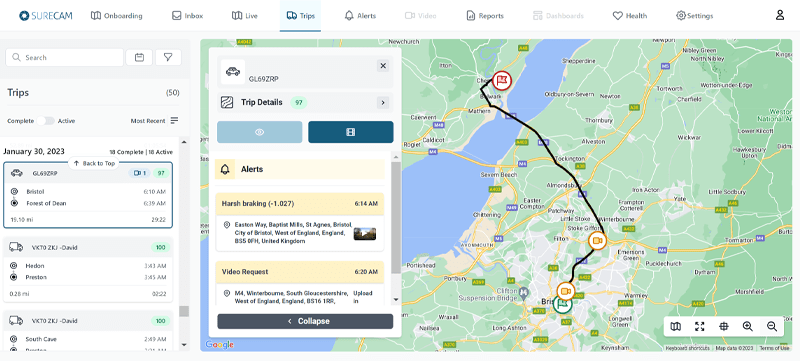9 UK Fleet Safety Trends to Watch in 2024

Big changes for the transportation industry
UK fleet managers are currently adjusting to several new developments and obstacles. The introduction of advanced technology, an increase in data availability, and potential shifts in management strategies stand out as critical focus areas. SureCam is dedicated to assisting safety managers in staying abreast of these swift changes. We have identified the top nine fleet safety trends, including an essential update for UK audiences on the Direct Vision Standard (DVS).
Broad Adoption of Fleet Cameras
Transformation in Fleet Safety Management
Understanding Direct Standards Zones
Data Management and Utilisation
Adaptation to New Drug Testing Policies
Addressing the Driver Shortage
Public Engagement with Technology Education
1. Broad Adoption of Fleet Cameras
The enforcement of the WTD mandate has led to a surge in the integration of fleet vehicle technology including dash cams, aiming to accurately capture driver performance, lower insurance claims, and incident rates. These devices offer valuable insights for evaluating driver performance and are crucial in disproving unfounded claims against drivers. Discussing the advantages of these cameras during safety meetings is advisable.
2. Transformation in Fleet Safety Management
The role of fleet safety managers is undergoing a transformation, shifting towards a broader, more strategic perspective. It’s a change driven by the need to integrate an ever-increasing volume of data from driver monitoring systems into daily operations. Managers are now tasked with not only processing this data but also strategizing on the long-term incorporation of technological advancements into their fleets while maintaining clear and effective communication with their drivers about these changes.
3. Understanding Direct Vision Standards (DVS) Zones
DVS Zones in London aim to enhance road safety by improving HGV driver visibility. With TfL's updated regulations requiring a minimum visibility rating, ensuring compliance is now more crucial than ever. Dash cams have become indispensable tools for ensuring DVS compliance and giving drivers added visibility within the cab, providing evidence in disputes and improving road safety.
Upgrading vehicles with safety systems, ensuring proper vehicle registration and certification, and educating drivers on DVS regulations are key steps towards compliance. Using mapping tools for strategic route planning can aid in avoiding DVS Zones, thereby optimizing compliance and operational efficiency.
4. Data Management and Utilisation
The explosion of telematics within the transport sector offers unprecedented opportunities and challenges. This technology provides critical insights that can enhance driver safety practices, boost fuel efficiency, and reduce the costs associated with claims. However, the sheer volume of data available can be daunting. Fleet managers must prioritise the most impactful data, streamlining their focus to prevent information overload and ensure they are not investing in unnecessary tools. Best-in-class fleet technology providers like SureCam have methodology for best handling the avalanche of fleet data so that it doesn’t become a liability within your business.
5. Cyber Security Prioritisation
Today, data is a true goldmine, and protecting it is of utmost importance. Fleet managers must navigate the complexities of cyber security, ensuring that the vast amounts of collected data are not only secure but also used responsibly. It's imperative to understand the security measures in place by their data providers and to ensure clarity around the recording, access, and storage of information to protect against cyber threats.
6. Adaptation to New Drug Testing Policies
The legalisation of medical cannabis across regions has prompted a reevaluation of drug testing protocols within the transport sector. These changes necessitate a more rigorous approach to drug testing, especially for drivers who traverse multiple jurisdictions. Fleet safety managers are now responsible for developing and implementing policies that safeguard their drivers from the implications of these legal changes, ensuring safety and compliance.
7. Conducting Regular Safety Meetings
The importance of regular safety meetings has been magnified by the rapid pace of technological advancements and policy changes. These meetings offer a platform to discuss new technologies, data insights, and any concerns drivers may have. Tailoring the agenda to address specific interests or worries of the team can significantly enhance engagement and foster a culture of safety and awareness within the company.
8. Addressing the Driver Shortage
The ongoing shortage of qualified drivers continues to pose significant challenges to the industry, compelling fleets to consider hiring younger and less experienced drivers. These individuals stand to gain immensely from the insights provided by telematics and dash cams, which can offer substantial coaching and safety training. It's crucial for fleet managers to proactively address safety concerns and provide adequate support and training to these new team members.
9. Public Engagement with Technology Education
The rapid adoption of new driving technologies has spurred public interest and led to the introduction of Tech-Education initiatives. These programmes aim to educate the public and industry professionals about the benefits and workings of driver assistance and automated vehicle technologies through courses and nationwide events. Such efforts are invaluable for fleet managers, keeping them abreast of technological advancements and providing resources to ensure their fleets remain competitive and informed.
Fleet safety standards are changing day by day. As the UK transport sector continues to evolve, staying informed and adaptable to these emerging trends and regulatory requirements is non-negotiable for fleet managers and business owners. SureCam is committed to providing the tools and support necessary to navigate these changes successfully, ensuring fleets are safe, compliant, and efficient.





